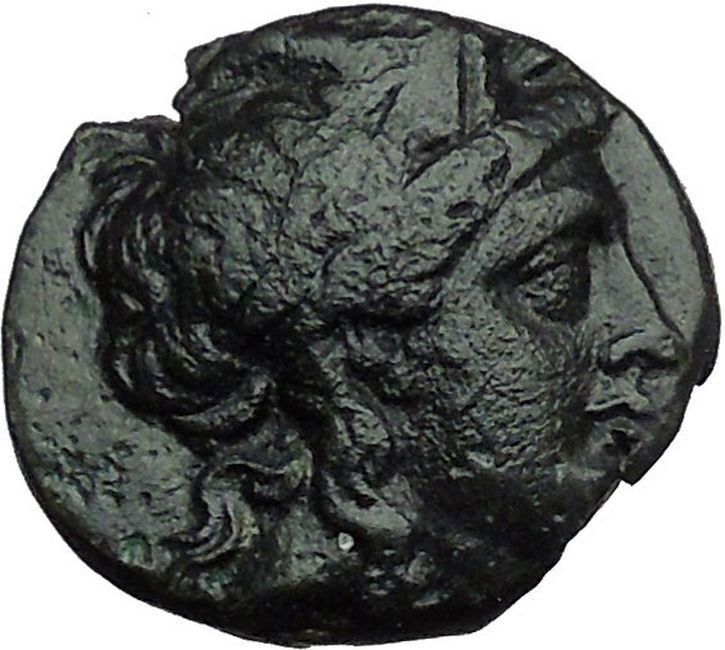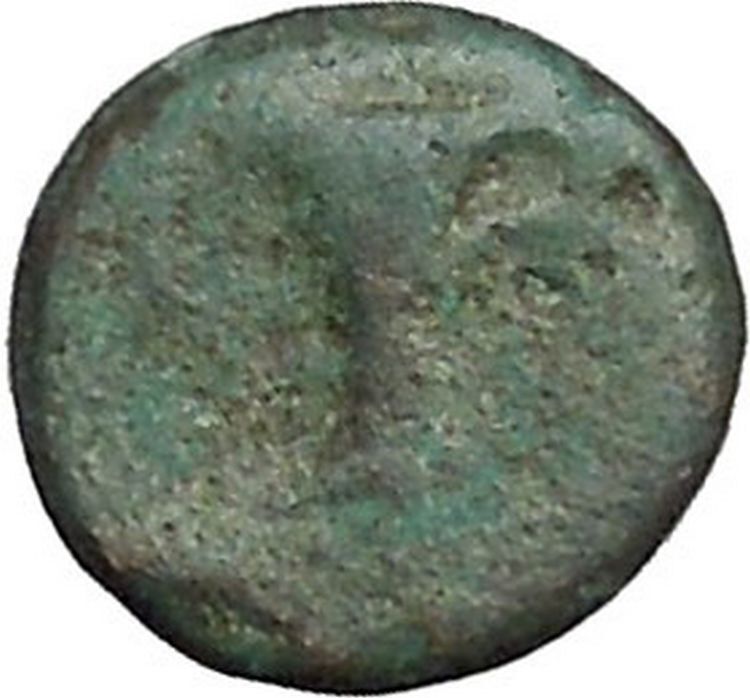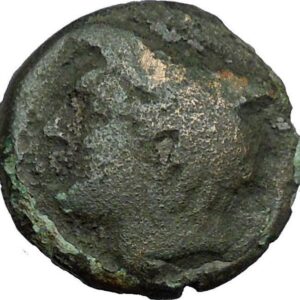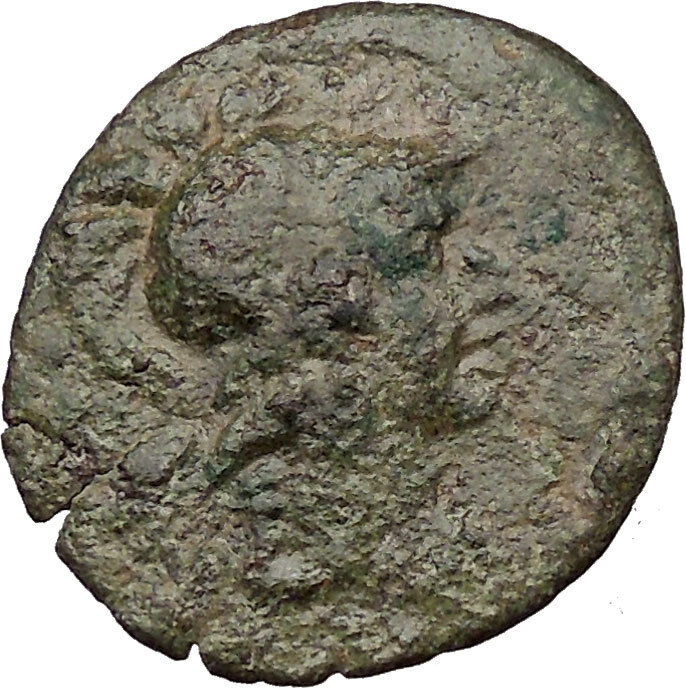|
Greek coin of The Brettii (Brettian League) in Bruttium
Bronze Drachm 22mm (7.36 grams) Struck circa 214-211 B.C.
Reference: Sear 704; Scheu, Bronze 14; HN Italy 1978
Laureate head of Zeus right; grain ear behind.
BPETTIΩN, Eagle with spread wings standing left; crescent above, cornucopia to left.
This coin was struck during the time of the Second Punic War, under the Brettian league which sided with Hannibal against the Romans.
You are bidding on the exact item pictured, provided with a Certificate of Authenticity and Lifetime Guarantee of Authenticity.
The Second Punic War, also referred to as The Hannibalic War, (by the Romans) The War Against Hannibal, or “The Carthaginian War”, lasted from 218 to 201 BC and involved combatants in the western and eastern Mediterranean. This was the second major war between Carthage and the Roman Republic, with the crucial participation of Numidian-Berber armies and tribes on both sides. The two states had three major conflicts against each other over the course of their existence. They are called the “Punic Wars” because Rome’s name for Carthaginians was Poeni, derived from Poenici (earlier form of Punici), a reference to the colonisation of Carthage by the Phoenicians.
The war was to a considerable extent initiated by Rome but is marked by Hannibal‘s surprising overland journey and his costly crossing of the Alps, followed by his reinforcement by Gaulish allies and crushing victories over Roman armies in the battle of the Trebia and the giant ambush at Trasimene. The following year (216) Hannibal’s army defeated the Romans again, this time in southern Italy at Cannae. In consequence of these defeats, many Roman allies went over to Carthage, prolonging the war in Italy for over a decade. Against Hannibal’s skill on the battlefield, the Romans deployed the Fabian strategy. Roman forces were more capable in siegecraft than the Carthaginians and recaptured all the major cities that had joined the enemy, as well as defeating a Carthaginian attempt to reinforce Hannibal at the battle of the Metaurus. In the meantime, in Iberia, which served as the main source of manpower for the Carthaginian army, a second Roman expedition under Publius Cornelius Scipio Africanus Major took New Carthage by assault and ended Carthaginian rule over Iberia in the battle of Ilipa. The final showdown was the Battle of Zama in Africa between Scipio Africanus and Hannibal, resulting in the latter’s defeat and the imposition of harsh peace conditions on Carthage, which ceased to be a major power and became a Roman client-state.
A sideshow of this war was the indecisive First Macedonian War in the Eastern Mediterranean and the Ionian Sea.
All battles mentioned in the introduction are ranked among the most costly traditional battles of human history
![The Jupiter de Smyrne, discovered in Smyrna in 1680[1]](https://upload.wikimedia.org/wikipedia/commons/thumb/c/c8/Jupiter_Smyrna_Louvre_Ma13.jpg/200px-Jupiter_Smyrna_Louvre_Ma13.jpg) In the ancient Greek religion, Zeus was the “Father of Gods and men” who ruled the Olympians of Mount Olympus as a father ruled the family. He was the god of sky and thunder in Greek mythology. His Roman counterpart is Jupiter and Etruscan counterpart is Tinia. In the ancient Greek religion, Zeus was the “Father of Gods and men” who ruled the Olympians of Mount Olympus as a father ruled the family. He was the god of sky and thunder in Greek mythology. His Roman counterpart is Jupiter and Etruscan counterpart is Tinia.
Zeus was the child of Cronus and Rhea, and the youngest of his siblings. In most traditions he was married to Hera, although, at the oracle of Dodona, his consort was Dione: according to the Iliad, he is the father of Aphrodite by Dione. He is known for his erotic escapades. These resulted in many godly and heroic offspring, including Athena, Apollo and Artemis, Hermes, Persephone (by Demeter), Dionysus, Perseus, Heracles, Helen of Troy, Minos, and the Muses (by Mnemosyne); by Hera, he is usually said to have fathered Ares, Hebe and Hephaestus.
As Walter Burkert points out in his book, Greek Religion, “Even the gods who are not his natural children address him as Father, and all the gods rise in his presence.” For the Greeks, he was the King of the Gods, who oversaw the universe. As Pausanias observed, “That Zeus is king in heaven is a saying common to all men”. In Hesiod’s Theogony Zeus assigns the various gods their roles. In the Homeric Hymns he is referred to as the chieftain of the gods.
His symbols are the thunderbolt, eagle, bull, and oak. In addition to his Indo-European inheritance, the classical “cloud-gatherer” also derives certain iconographic traits from the cultures of the Ancient Near East, such as the scepter. Zeus is frequently depicted by Greek artists in one of two poses: standing, striding forward, with a thunderbolt leveled in his raised right hand, or seated in majesty.
The Bruttii (Greek: Βρέττιοι, Italian: Bruzi), were an ancient Italic people who inhabited the southern extremity of Italy, from the frontiers of Lucania to the Sicilian Straits and the promontory of Leucopetra, roughly corresponding to modern Calabria.
The Bruttii spoke Oscan, as attested by several finds of Oscan script, though this may have been a later influence from their sabellic neighbors, the Lucani.
Both Greek and Latin writers expressly tell us that Bruttii was the name of the people: no separate designation for the country or province appears to have been adopted by the Romans, who almost universally use the plural form, or name of the nation, to designate the region which they inhabited. Thus Livy uses Consentia in Bruttiis, extremus Italiae angulus Bruttii, Bruttii provincia, etc.: and the same usage prevailed down to a very late period. The name of Bruttium to designate the province or region, though adopted by almost all modern writers on ancient geography appears to be unsupported by any classical authority: Pomponius Mela, indeed, uses in one passage the phrase in Bruttio, but it is probable that this is merely an elliptic expression for in Bruttio agro, the term used by him in another passage, as well as by many other writers. The Greeks, however, used Βρεττία for the name of the country, reserving Βρέττιοι for that of the people. Polybius, in more than one passage, calls it ἡ Βρεττιανὴ Χώρα
The land of the Bruttians, or Bruttium, was bounded on the north by Lucania, from which it was separated by a line drawn from the river Laus near the Tyrrhenian Sea to the Crathis near the Gulf of Tarentum. On the west it was washed by the Tyrrhenian Sea, and on the south and east by that known in ancient times as the Sicilian Sea, including under that appellation the Gulf of Tarentum.
All ancient authors agree in stating that neither the name nor the origin of the Bruttians could claim a very remote antiquity. The country occupied by them was inhabited, in the earliest times described by ancient historians, by the Oenotrians – a tribe of Pelasgian origin, of which the Conii and Morgetes appear to have been merely subordinate divisions. It was while the Oenotrians were still masters of the land that the first Greek settlers arrived; and the beauty of the climate and country, as well as the rapid prosperity attained by these first settlements, proved so attractive that within a few years the shores of Bruttium were completely encircled by a belt of Greek colonies, part of Magna Graecia. There are few other informations about the exact relations between these Greek cities and the native Oenotrian tribes, though most likely the latter were reduced to a state of dependence, and at one time at least of complete subjection. The territories of the Greek cities comprised the whole line of coast, so that those of Crotona and Thurii met at the river Hylias, and those of Locri and Rhegium were separated only by the Halex; since both Crotona and Locri founded colonies on the opposite side of the peninsula, most likely the intermediate districts also were at least nominally subject to them.
Such appears to have been the state of things at the time of the Peloponnesian War; but in the course of the following century a great change took place. The Sabellian tribe of the Lucanians, who had been gradually extending their conquests towards the south, and had already made themselves masters of the northern parts of Oenotria, now pressed forwards into the Bruttian peninsula, and established their dominion over the interior of that country, reducing its previous inhabitants to a state of vassalage or serfdom. This probably took place after their great victory over the Thurians, near Laus, in 390 BCE; and little more than 30 years elapsed between this event and the rise of the people, properly called Bruttians. These are represented by ancient authors as merely a congregation of revolted slaves and other fugitives, who had taken refuge in the wild mountain regions of the peninsula: it seems probable that a considerable portion of them were the native Oenotrian or Pelasgic inhabitants, who gladly embraced the opportunity to throw off the foreign yoke. But Justin distinctly describes them as headed by youths of Lucanian race; and there appears sufficient evidence of their close connection with the Lucanians to warrant the assumption that these formed an important ingredient in their national composition.
The name of Bruttii (Βρέττιοι) was given them, it seems, not by the Greeks, but by the Lucanians, and signified in their language rebels (δραπέται, ἀποστάται). But though used at first as a term of reproach, it was subsequently adopted by the Bruttians themselves, who, when they had risen to the rank of a powerful nation, pretended to derive it from a hero named Bruttus (Βρέττος), the son of Hercules and Valentia. Justin, on the other hand, represents them as deriving their name from a woman of the name of Bruttia, who figured in their first revolt, and who, in later versions of the legend, assumes the dignity of a queen.
The rise of the Bruttian people from this fortuitous aggregation of rebels and fugitives is assigned by Diodorus to the year 356 BCE; and this accords with the statement of Strabo that they arose at the period of the expedition of Dion against the younger Dionysius. The wars of the latter, as well as of his father, with the Greek cities in southern Italy, and the state of confusion and weakness to which these were reduced in consequence, probably contributed in a great degree to pave the way for the rise of the Bruttian power. The name must indeed have been much more ancient, since Diodorus, in another passage, speaks of the Bruttians as having expelled the remainder of the Sybarites, who had settled on the river Traeis after the destruction of their own city. But it is probable that this is a mere inaccuracy of expression, and that he only means to designate the inhabitants of the country, who were afterwards called Bruttians. Stephanus of Byzantium, indeed, cites Antiochus of Syracuse, as using the name of Brettia for this part of Italy, but this seems to be clearly a mistake. It is more remarkable that, according to the same authority, the name of Brettian as an adjective (μελαίνη γλώσσα Βρεττία) was used by Aristophanes, at least 30 years before the date assigned for the rise of the nation. The progress of the latter, after their first appearance in history, was rapid. Composed originally of mere troops of outlaws and bandits, they soon became numerous and powerful enough to defy the arms of the Lucanians, and not only maintained their independence in the mountain districts of the interior, but attacked and made themselves masters of the Greek cities of Hipponium, Terina, and Thurii. Their independence seems to have been readily acknowledged by the Lucanians; and less than 30 years after their first revolt, the two nations united their arms as allies against their Greek neighbors. The latter applied for assistance to Alexander, king of Epirus, who crossed over into Italy with an army, and carried on the war for several successive campaigns, during which he reduced Heraclea, Consentia (modern Cosenza), and Terina; but finally perished in a battle against the combined forces of the Lucanians and Bruttians, near Pandosia, 326 BCE.
They next had to contend against the arms of Agathocles, who ravaged their coasts with his fleets, took the city of Hipponium, which he converted into a strong fortress and naval station, and compelled the Bruttians to conclude a disadvantageous peace. But they soon broke this treaty; and recovered possession of Hipponium. This appears to have been the period when the Bruttian nation had reached its highest pitch of power and prosperity; it was not long before they had to contend with a more formidable adversary, and as early as 282 BCE they joined and the Lucanians and Samnites against the growing power of Rome. A few years later they are mentioned as sending auxiliaries to the army of Pyrrhus; but after the defeat of that monarch, and his expulsion from Italy, they had to bear the full brunt of the war, and after repeated campaigns and successive triumphs of the Roman generals, Gaius Fabricius Luscinus and Lucius Papirius, they were finally reduced to submission, and compelled to purchase peace by the surrender of one-half of the great forest of Sila, so valuable for its pitch and timber.
Their submission however was still but imperfect; and though they regained tranquil throughout the First Punic War, the successes of Hannibal in the Second, proved too much for their fidelity, and the Bruttians were among the first to declare in favor of the Carthaginian general after the Battle of Cannae. The defection of the people did not indeed in the first instance draw with it that of the towns: but Petelia and Consentia, which had at first held aloof, were speedily reduced by the Bruttians, assisted by a small Carthaginian force, and the more important cities of Locri and Crotona followed not long after. Rhegium alone remained firm, and was able to defy the Carthaginian arms throughout the war. In 215 BCE, Hanno, the lieutenant of Hannibal, after his defeat at Grumentum by Tiberius Gracchus, threw himself into Bruttium, where he was soon after joined by a body of fresh troops from Carthage under Bomilcar: and from this time he made that region his stronghold, from whence he repeatedly issued to oppose the Roman generals in Lucania and Samnium, while he constantly fell back upon it as a place of safety when defeated or hard pressed by the enemy. The physical character of the country rendered it necessarily a military position of the greatest strength: and after the defeat and death of Hasdrubal Hannibal himself put forces into some Bruttian territory, where he continued to maintain his ground against the Roman generals. There are very little information concerning the operations of the four years during which Hannibal retained his positions in this province: he appears to have made his headquarters for the most part in the neighbourhood of Crotona, but the name of Castra Hannibalis retained by a small town on the Gulf of Squillace, points to his having occupied this also as a permanent station. Meanwhile the Romans, though avoiding any decisive engagement, were continually gaining ground on him by the successive reduction of towns and fortresses, so that very few of these remained in the hands of the Carthaginian general, when he was finally recalled from Italy.
The ravages of so many successive campaigns must have already inflicted a severe blow upon the prosperity of Bruttium: the measures adopted by the Romans to punish them for their rebellion completed their humiliation. They were deprived of a great part of their territory, and the whole nation reduced to a state bordering on servitude: they were not admitted like the other nations of Italy to rank as allies, but were pronounced incapable of military service, and only employed to attend upon the Roman magistrates as couriers or letter-carriers, and attendants for other purposes of a menial character. It was however some time before they were altogether crushed: for several years after the close of the Second Punic War, one of the praetors was annually sent with an army to watch over the Bruttians: and it was evidently with the view of more fully securing their subjection that three colonies were established in their territory, two of Roman citizens at Tempsa and Crotona, and a third with Latin rights at Hipponium, to which the name of Vibo Valentia was now given. A fourth was at the same time settled at Thurii on their immediate frontier.
From this time the Bruttians as a people disappear from history: but their country again became the theatre of war during the revolt of Spartacus, who after his first defeats by Crassus, took refuge in the southernmost portion of Bruttium (called by Plutarch the Rhegian peninsula), in which the Roman general sought to confine him by drawing lines of intrenchment across the isthmus from sea to sea. The insurgent leader however forced his way through, and again carried the war into the heart of Lucania. During the Civil Wars the coasts of Bruttium were repeatedly laid waste by the fleets of Sextus Pompeius, and witnessed several conflicts between the latter and those of Octavian, who had established the headquarters both of his army and navy at Vibo. Strabo speaks of the whole province as reduced in his time to a state of complete decay. It was included by Augustus in the Third Region (Regio III), together with Lucania; and the two provinces appear to have continued united for most administrative purposes until the fall of the Roman Empire, and were governed conjointly by a magistrate termed a Corrector. The Liber Coloniarum however treats of the Provincia Bruttiorum as distinct from that of Lucania.
|





![The Jupiter de Smyrne, discovered in Smyrna in 1680[1]](https://upload.wikimedia.org/wikipedia/commons/thumb/c/c8/Jupiter_Smyrna_Louvre_Ma13.jpg/200px-Jupiter_Smyrna_Louvre_Ma13.jpg)





